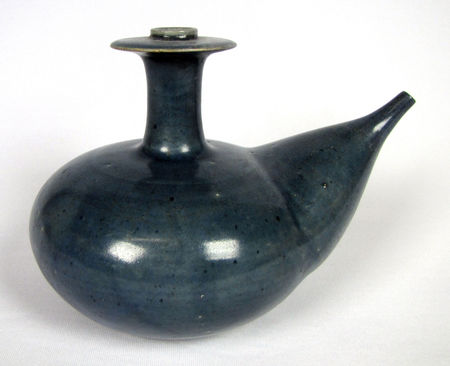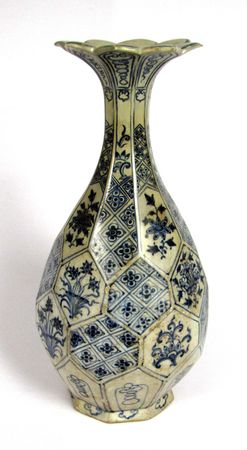"GÔM SÚ’. Ceramics from Viêt Nam, a 2000-Year History" @ MAK Vienna
Plate with raised foliated rim. Vietnam, Lê Dynasty (1428—1527), 2nd half l5th century. Stoneware with decoration in cobalt blue under as well as in green and red on glaze (onglaze decoration added), parrot perched on branch. HS Collection ©MAK
VIENNA - A cross-section of Vietnamese ceramics more complete than any yet shown in Vienna will be on display from 19 October in the Asia section ofthe MAK Permanent Collection. The exhibition GOM SU’. Ceramics from Vietnam, a 2,000-Year History will draw an arc from the very first typically Vietnamese forms to particularly colorful and formally interesting lSth and l6th-century products, and will at the same time provide insight into Vietnamese art history in general.
European knowledge of East and Southeast Asian ceramics pertains largely ta Chinese and Japanese porcelain, which was globally disseminated over many centuries thanks to intense export activities. The exhibition GOM SÛ’. Ceramics from Vietnam, a 2,000-Year History steers attention away from the “Middle Kingdom,” which periodically heid cultural sway over its neighbors, and towards the less-known but equally tradition-steeped and independent ceramics production of Vietnam.
Beginning in the 3rd century AD, Vietnam—due ta the wake of Emperor Qin Shi Huang’s unification of China and expansionary efforts—was subject to (above ail southern) Chinese political and cultural influence. Burial objects suggest that Chinese techniques, religions and cuits were assimilated, whereas artistically independent forms of expression were stili sought after. The typical Vietnamese handled cup dates back ta this early period. This era wili be illustrated using outstanding historicai examples Their origins lie in metal moids from centrai Asia as well as bronze castings which had traveled from Yunnan to Vietnam.
From the seventh century AD onward, intensifying sea traffic between Asian countries facilitated close trade relations between East and Southeast Asian lands as well as those in central and western Asia. The production cf ceramics meant for daily use grew to represent an important share of exports. Ceramic objects from this period exhibit a wide diversity cf forms and highly varied decors. Particularly conspicuous are those which were intentionally decorated with spiatters cf colored giaze. The calligraphic character cf such designs can be read as a reinterpretation cf Chinese export products.
Among the upper class in Japan, Vietnamese ceramics were quite highly appreciated. Tea ceremonies often employed tea bowis from the northern Vietnamese L9 Dynasty (1009—1225), objects which light-colored glazes and lotus-leaf decors were very much characterized by Buddhist spirituaiity. Pots from Thanh-Hôa were used ta hold water. Archeological excavations in Thanh Hôa Province during the 1930s turned up large storage vessels with figurai and floral decors which were produced flot only for local use, but also for export across ail of Asia. A Thanh-Hôa pot purchased in Japan and shown in the exhibition serves to document how these pots were given new functions after their arrivai in “distant lands.”
During the Tran Dynasty (1225—1 400), Vietnam was the only Asian state to successfuily fought resistance against the Mongols under Kublai Khan. In the fields of art and culture, these rulers oriented themselves toward China—a fact which was reflected both in the style and in technique applied to ceramics:
white stoneware with cobalt-blue décor was produced almost contemporaneously with Chinas early “blue-and-white” porcelain.
Rare vases with cobalt-blue décor, as well as plates and platters painted in multiple colors, are one ofthe highlights ofthis exhibition. This group of multifaceted ceramics from the Lê Dynasty (1428—1 527) is notable above ail for its abundance of colors and forms.
Ceramic objects indicate cultural and technical developments to an extent hardly equaied by any other material. GOM SU’, an extensive exhibition of Vietnamese ceramics largely relies on objects from a private collection. The exhibition concept was first pursued in CROSSO VER. Two collections— Private and Public (26 October 2010—27 March 2011). With CROSSO VER— which was partly based on objects from the same private coliection—having provided insight into the history and art history of Korea, Thailand and Cambodia, GÔM SÙ’ now introduces the creative richness of a further Asian country.
This exhibition will be accompanied by a video installation by Nives Widauer: her slow-motion video kambium, created in 2006, wiil be triple-projected onto the plateau in the middie of the hall and thus serve to continue the earthy coloration ofthe Vietnamese ceramics in a present-day medium. The video’s meditative nature footage will underscore the caIrn atmosphere of the exhibition and its architecture.

Bird-shaped Object. North Vietnam, Thanh Hôa Province, Dong Son Culture (2000 B C—200 AD), ca. 500—200 BC. Earthenware, hand-formed, with incised decoration; usage unknown. HS Collection ©MAK
Kendi. Vietnam, Late Lé Dynasty (1428-1527), l5th century. Stoneware with cobalt blue crackled glaze. HS Collection ©MAK
Plate with raised foliated rim. Vietnam, Lê Dynasty (1428—1527), 2nd half l5th century. Stoneware with decoration in cobalt blue under as well as in green and red on glaze (onglaze decoration added), parrot perched on branch. HS Collection ©MAK
Five-Pot Object. North Vietnam, transition Dong Son Culture / Han-Vietnamese Period, ca. 100 BC—100 AD. Earthenware with ash glaze, pots thrown singly and attached together. HS Collection ©MAK
Beaker with handie (libation vessel). North Vietnam, Thanh Hôa Province, Han-Wetnamese Period (lst—6th centuryAD), ca. 0-200AD. Stoneware with crackled glaze. HS Collection ©MAK
SmalI Jug. North Vietnam, L Dynasty (1009-1225), l2th-l3th century. Stoneware with lotus-petal collar under crackled glaze. HS Collection
©MAK
Storage Container, so-called Thanh Hoa Pot. North Vietnam, Thanh Hôa Province, Ly’ Dynasty (1009-1225), l2th-l3th century. Stoneware with incised decoration and brown slip under ivory-coloured glaze. HS Collection ©MAK
Jug. Vietnam, Ly' Dynasty (1009-1225), 11th-l3th century. Stoneware with lotus-petals in incised decoration and painting with brown slip under crackled glaze. HS Collection ©MAK
Plate. Vietnam, Trân Dynasty (1225-1400), l4th century. Stoneware with painted chrysanthemum flower in iron-brown under glaze. HS Collection ©MAK
Bottle (yuhuchun). Vietnam, Lê Dynasty (1428-1527), 2nd half l5th century. Stoneware, slightly facetted, with partially openwork, originally gilt medallions and wave decoration in cobalt blue under glaze: sea find. HS Collection ©MAK
Bottle (yuhuchun). Vietnam, Lê Dynasty (1428-1527), l5th century. Stoneware with hexagonal facetted fields, octagonal foot and protruding rim in lotus blossom form, with floral decoration in cobalt blue under glaze; neck restored. HS Collection ©MAK
Kendi in toad form. Vietnam, Lê Dynasty (1428—1527), 2nd haif l5th century to 1st half l6th century. Stoneware with decoration in the enamel colours iron red, yellow and green on transparent crackled glaze. HS Collection ©MAK
Plate. Vietnam, Lé Dynasty (1428-1527), l5th century. Stoneware with decoration in cobalt blue under glaze, potters mark on the back. HS Collection ©MAK
MAK-Exhibition view GÔM SU. Ceramics from Vietnam, a 2, 000-Year History. MAK Permanent Collection Asia © MAK/Georg Mayer

/https%3A%2F%2Fprofilepics.canalblog.com%2Fprofilepics%2F1%2F0%2F100183.jpg)
/https%3A%2F%2Fstorage.canalblog.com%2F03%2F02%2F119589%2F96711876_o.jpg)
/https%3A%2F%2Fstorage.canalblog.com%2F11%2F31%2F119589%2F94773502_o.jpg)
/https%3A%2F%2Fstorage.canalblog.com%2F20%2F83%2F119589%2F94772815_o.jpg)
/https%3A%2F%2Fstorage.canalblog.com%2F26%2F72%2F119589%2F75604929_o.jpg)
/https%3A%2F%2Fstorage.canalblog.com%2F59%2F60%2F119589%2F26458628_o.jpg)


























/image%2F1371349%2F20240309%2Fob_cc1354_41.png)
/image%2F1371349%2F20240227%2Fob_aab771_ash-glazed-lian-container-with-three-l.jpg)
/http%3A%2F%2Fstorage.canalblog.com%2F11%2F09%2F119589%2F129818349_o.jpg)
/http%3A%2F%2Fstorage.canalblog.com%2F55%2F89%2F119589%2F129509226_o.jpg)